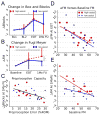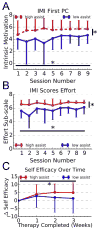Robotic Assistance for Training Finger Movement Using a Hebbian Model: A Randomized Controlled Trial
- PMID: 28803535
- PMCID: PMC5894506
- DOI: 10.1177/1545968317721975
Robotic Assistance for Training Finger Movement Using a Hebbian Model: A Randomized Controlled Trial
Abstract
Background: Robots that physically assist movement are increasingly used in rehabilitation therapy after stroke, yet some studies suggest robotic assistance discourages effort and reduces motor learning.
Objective: To determine the therapeutic effects of high and low levels of robotic assistance during finger training.
Methods: We designed a protocol that varied the amount of robotic assistance while controlling the number, amplitude, and exerted effort of training movements. Participants (n = 30) with a chronic stroke and moderate hemiparesis (average Box and Blocks Test 32 ± 18 and upper extremity Fugl-Meyer score 46 ± 12) actively moved their index and middle fingers to targets to play a musical game similar to GuitarHero 3 h/wk for 3 weeks. The participants were randomized to receive high assistance (causing 82% success at hitting targets) or low assistance (55% success). Participants performed ~8000 movements during 9 training sessions.
Results: Both groups improved significantly at the 1-month follow-up on functional and impairment-based motor outcomes, on depression scores, and on self-efficacy of hand function, with no difference between groups in the primary endpoint (change in Box and Blocks). High assistance boosted motivation, as well as secondary motor outcomes (Fugl-Meyer and Lateral Pinch Strength)-particularly for individuals with more severe finger motor deficits. Individuals with impaired finger proprioception at baseline benefited less from the training.
Conclusions: Robot-assisted training can promote key psychological outcomes known to modulate motor learning and retention. Furthermore, the therapeutic effectiveness of robotic assistance appears to derive at least in part from proprioceptive stimulation, consistent with a Hebbian plasticity model.
Keywords: hand; movement; proprioception; rehabilitation; robotics; stroke.
Figures




Similar articles
-
The Role of Robotic Path Assistance and Weight Support in Facilitating 3D Movements in Individuals With Poststroke Hemiparesis.Neurorehabil Neural Repair. 2020 Feb;34(2):134-147. doi: 10.1177/1545968319887685. Epub 2020 Jan 20. Neurorehabil Neural Repair. 2020. PMID: 31959040
-
A crossover pilot study evaluating the functional outcomes of two different types of robotic movement training in chronic stroke survivors using the arm exoskeleton BONES.J Neuroeng Rehabil. 2013 Dec 19;10:112. doi: 10.1186/1743-0003-10-112. J Neuroeng Rehabil. 2013. PMID: 24354476 Free PMC article. Clinical Trial.
-
Does assist-as-needed upper limb robotic therapy promote participation in repetitive activity-based motor training in sub-acute stroke patients with severe paresis?NeuroRehabilitation. 2017;41(1):31-39. doi: 10.3233/NRE-171454. NeuroRehabilitation. 2017. PMID: 28527224
-
Hand Rehabilitation Robotics on Poststroke Motor Recovery.Behav Neurol. 2017;2017:3908135. doi: 10.1155/2017/3908135. Epub 2017 Nov 2. Behav Neurol. 2017. PMID: 29230081 Free PMC article. Review.
-
Application of the CIT concept in the clinical environment: hurdles, practicalities, and clinical benefits.Cogn Behav Neurol. 2006 Mar;19(1):48-54. doi: 10.1097/00146965-200603000-00006. Cogn Behav Neurol. 2006. PMID: 16633019 Review.
Cited by
-
Using a Webcam to Assess Upper Extremity Proprioception: Experimental Validation and Application to Persons Post Stroke.Sensors (Basel). 2024 Nov 21;24(23):7434. doi: 10.3390/s24237434. Sensors (Basel). 2024. PMID: 39685974 Free PMC article.
-
Using Large-Scale Sensor Data to Test Factors Predictive of Perseverance in Home Movement Rehabilitation: Optimal Challenge and Steady Engagement.Front Neurol. 2022 Jun 20;13:896298. doi: 10.3389/fneur.2022.896298. eCollection 2022. Front Neurol. 2022. PMID: 35795800 Free PMC article.
-
Feasibility of Wearable Sensing for In-Home Finger Rehabilitation Early After Stroke.IEEE Trans Neural Syst Rehabil Eng. 2020 Jun;28(6):1363-1372. doi: 10.1109/TNSRE.2020.2988177. Epub 2020 Apr 15. IEEE Trans Neural Syst Rehabil Eng. 2020. PMID: 32305930 Free PMC article.
-
Integration of music-based game approaches with wearable devices for hand neurorehabilitation: a narrative review.J Neuroeng Rehabil. 2024 May 29;21(1):89. doi: 10.1186/s12984-024-01379-w. J Neuroeng Rehabil. 2024. PMID: 38811987 Free PMC article. Review.
-
Flexohand: A Hybrid Exoskeleton-Based Novel Hand Rehabilitation Device.Micromachines (Basel). 2021 Oct 20;12(11):1274. doi: 10.3390/mi12111274. Micromachines (Basel). 2021. PMID: 34832686 Free PMC article.
References
-
- Housman SJ, Scott KM, Reinkensmeyer DJ. A Randomized Controlled Trial of Gravity-Supported, Computer-Enhanced Arm Exercise for Individuals With Severe Hemiparesis. Neurorehabil Neural Repair. 2009;23(5):505–514. - PubMed
-
- Riener R, Nef T, Colombo G. Robot-aided neurorehabilitation of the upper extremities. Med Biol Eng Comput. 2005;43(1):2–10. - PubMed
Publication types
MeSH terms
Grants and funding
LinkOut - more resources
Full Text Sources
Other Literature Sources
Medical

